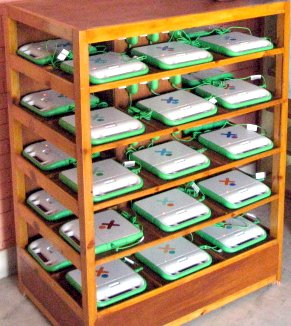Powering The Dream - With Electricity
Rwanda, Nauru, Madagascar
Although XOs need very little power, it adds up fast when you give one to each child.
Many rural and remote areas lack a reliable power source. From one of the poorest places in Rwanda comes a touching story on how XOs are having an unexpected impact on rural communities. At night in this village the XO is the only source of electric light for some families - their home has no electricity. This causes us to reflect on how deep are the many needs here.
Low power consumption is one of the features that make the XO is a revolutionary computing platform. The usage compared to the average laptops and the even more recent netbooks is much lower. The XO battery is long-lasting, quite reliable, and environmentally friendly.
The biggest challenge to power usage is attempting to power all the XOs in a classroom at the same time, or to charge them while they are being used. The battery charge lasts about three hours, depending on what Activities are used. The video camera uses the most.
An important priority for you to consider in your project is training users early on charger safe practices. Obviously parental help is desirable and recommended, but it do not assume it will be available to all children all the time.
For more advanced power topics, additional specs, and links for on line resources see general battery and power supply pointers in the OLPC wiki.
Deployments in developing countries need to consider the cost and the volume of the extra power requirements for the XOs. As mentioned above, sometimes you have to reinforce wiring in the schools. In most cases the students cannot charge their XOs at home. Multiple outlet plugs will have to be purchased to be able to plug in the computers in a classroom or location at school. Additionally, if you are using a School Server or wireless connection access points, you need wiring for those. It is convenient to build some sort of cage to prevent theft or damage.
 Rack to charge many XOs, OLE Nepal |
The XO gained early popular fame with the possibility of using alternative energy sources, given its low power needs. The prototype hand crank proved not to be practical, but solar panels do work, weather permitting. Although a 10 W panel can solar charge an XO directly in about three hours, their reliability long term has not been established yet, and obviously they would be rather useless during the rainy season in many countries.
In a village in Madagascar the XO deployment is "piggybacking" on a power generator installed there a couple years ago for an ice making plant. XO and other communication deployments can be a rationale for government or private/community infrastructure improvements, and in some circumstances this need has to be budgeted from the start, especially when dealing with several hundred XOs in each school.
| Most of the power alternatives for the XO are either in the early conceptual stage or at best in experimental use. This is an area that would benefit from realistic, devoted effort. |
Solar power has been used successfully by OLPC Oceania. The tiny island nation of Nauru has set up one of their elementary schools with one "solar classroom". It is equipped with panels on the roof and a connection in the classroom for charging the XOs. They are drawing on the experience of others in another OLPC Oceania pilot project in Papua, New Guinea. There, they decided to go 100% with DC share and 15W flexible GoldPeak panels with small capacitors integrated to avoid an oscillation problem. The cost is much reduced over having battery storage, and the laptops can be used while being charged. Others advocate the use of 20W panels if possible, or arrays to serve the whole school rather than individual households.
I want to add a little word of gratitude for the work that Richard Smith of OLPC has done in figuring out many of the most challenging parts of the power issues, and responding promptly with effective solutions when new fixes were needed.





